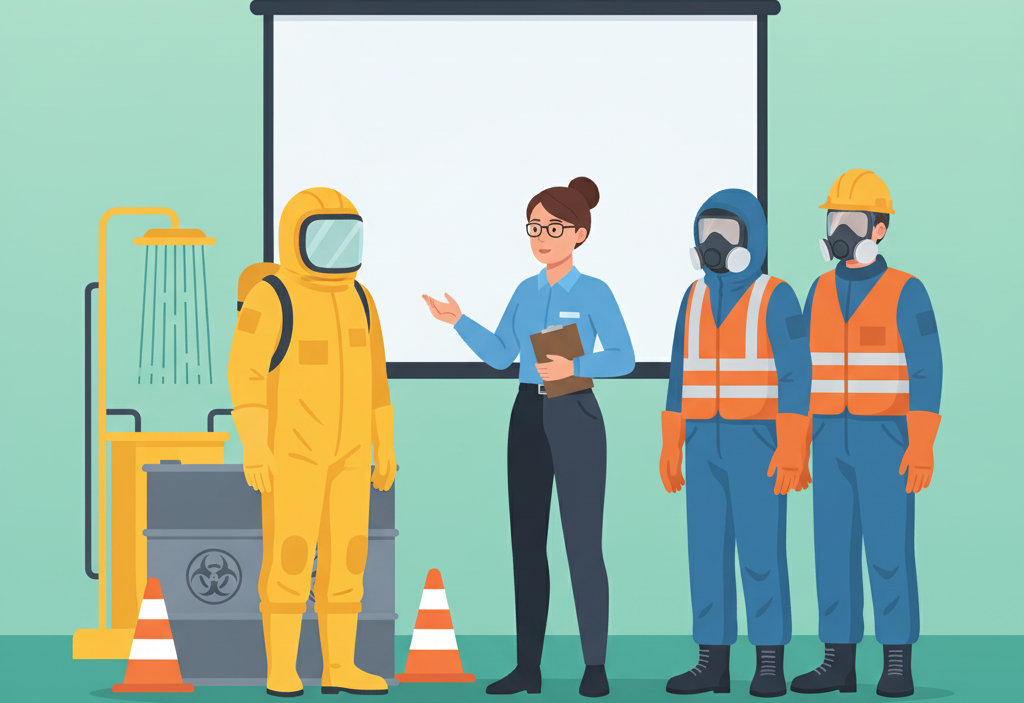OSHA Hazwoper Training is an essential certification for individuals working in industries where they may come into contact with hazardous waste operations or emergency response situations. This training equips workers with the necessary knowledge and skills to ensure their safety and the safety of others. In this article, we will explore what OSHA Hazwoper Training entails and why it is so important.
Safety and health are paramount at job sites that handle hazardous substances, and understanding the intricacies of this kind of training is essential for employees and employers alike. The HAZWOPER (Hazardous Waste Operations and Emergency Response) standard is specifically designed to protect workers at hazardous waste sites and is a critical component of workplace safety programs.
What Is OSHA Hazwoper Training?
OSHA Hazwoper Training is a specialized training program designed to educate workers about the potential dangers of working with hazardous materials. The training covers topics such as identifying hazardous substances, understanding the risks associated with them, and implementing safety measures to prevent accidents and injuries.
During the training, participants learn about the different levels of protection required for various hazardous waste operations and emergency response situations. They also gain knowledge on how to properly use personal protective equipment (PPE) and handle hazardous materials safely. Participants are educated on the different types of PPE available, such as gloves, goggles, respirators, and protective clothing. They learn how to select, use, and maintain PPE to ensure its effectiveness in protecting against hazardous substances.
One of the key aspects of OSHA Hazwoper Training is the emphasis on hazard recognition and evaluation. Participants are taught how to identify different types of hazardous materials, including chemicals, biological agents, and radioactive substances. They learn about the potential health effects of exposure to these materials and the importance of conducting thorough risk assessments before starting any hazardous waste operation or emergency response.
Furthermore, the training program delves into the various regulations and standards set by OSHA to ensure the safety of workers involved in hazardous waste operations. Learners are educated on OSHA’s Hazard Communication Standard, which requires employers to provide information and training to employees about the hazardous chemicals they may be exposed to in the workplace.
Participants also learn about the importance of having an effective emergency response plan in place. They are taught how to develop and implement an emergency response plan that includes procedures for evacuations, communication, and medical assistance. The training emphasizes the need for regular drills and exercises to ensure that workers are prepared to respond effectively in case of an emergency.
By the end of the OSHA Hazwoper Training, participants are equipped with the knowledge and skills necessary to work safely and effectively in environments where hazardous materials are present. They understand the importance of following proper procedures, using appropriate protective measures, and being vigilant in identifying and mitigating potential hazards.
In conclusion, OSHA Hazwoper Training is a comprehensive program that prepares workers to handle hazardous materials and respond to emergencies in a safe and efficient manner. The training not only focuses on imparting knowledge but also emphasizes the development of practical skills and a safety-oriented mindset. By investing in Hazwoper Training, employers can ensure the well-being of their workers and maintain compliance with OSHA regulations.
Benefits of OSHA Hazwoper Training
HAZWOPER training has numerous advantages for workers and organizations in many industries. Here’s a concise overview of the key benefits:
- Enhanced Safety: Employees learn vital skills to ensure their safety and the safety of others while managing hazardous materials. This training reduces the likelihood of accidents and injuries in the workplace.
- Regulatory Compliance: One crucial benefit is staying compliant with OSHA’s HAZWOPER Standard, which is mandatory for workers who handle hazardous substances.
- Risk Management: Workers are educated on how to manage risks effectively, ensuring they know how to respond to emergencies involving hazardous waste.
- Health Protection: The training covers methods to shield oneself from health hazards, thus reducing the incidence of acute and chronic health issues related to hazardous material exposure.
- Skill Enhancement: It provides hands-on experience, arming workers with practical skills for dealing with hazardous waste in a safe manner.
- Professional Development: Employees also benefit from opportunities for professional growth, as the certification is recognized and often required across a range of sectors.
It is essential for workers involved in the treatment, storage, and disposal of hazardous waste to be adequately trained. HAZWOPER training equips them with the knowledge and practice needed to perform their tasks safely and within legal requirements. Also worth noting is that OSHA requires employers to provide Hazwoper Training to their employees before they are exposed to hazardous materials and operations. The level of training can vary based on the potential risks and responsibilities associated with a specific role, and it’s not limited to those directly handling hazardous materials but also includes supervisors overseeing these operations. OSHA necessitates that these folks complete a form of HAZWOPER education suitable to their function and the possibility of exposure to dangerous substances.
Training Requirements
The specific requirements for this training depend on the level of involvement a worker has with hazardous waste operations. OSHA has established different training levels based on the tasks performed and the potential exposures faced.
The most comprehensive is the 40-hour version, designed for employees with duties that could involve a presence on a regulated hazardous waste operation site, or general site workers who may be exposed to hazardous substances. They must also complete three days of supervised field experience.
Supervisors and managers overseeing hazardous waste operations must complete a minimum of 24 hours of initial training. Additionally, 24 hours is intended for occasional site workers who may face hazardous substances but are unlikely to exceed permissible exposure limits. In addition to the 24 hours of training, these workers are also required to undergo one day of field supervision.
Furthermore, both general site workers and supervisors are required to complete an 8-hour annual refresher training to stay up-to-date on any changes in regulations or procedures. This course reinforces key safety principles and updates the workers on any changes or developments in regulations or technologies.
Mandatory Topics and Hands-On Training
All HAZWOPER courses must cover a range of mandatory topics. These are stipulated by OSHA and include, but are not limited to:
- Hazard recognition
- Decontamination procedures
- Personal protective equipment
- Emergency response
- Understanding of OSHA’s regulations
Hands-on training is a crucial component that complements the instructional aspect. It ensures that workers can perform tasks and use equipment effectively in a controlled environment before they encounter real hazards. OSHA stipulates that employers are required to ensure that employees receive HAZWOPER training from qualified trainers, which includes interactive practical exercises reflective of their work conditions.
Difference Between Hazwoper 40 and OSHA 30
HAZWOPER 40 and OSHA 30 are both critical training programs developed by OSHA but serve different purposes. Understanding the differences is essential for professionals seeking the right safety training credentials.
HAZWOPER 40 Training:
- Aimed at workers involved in clean-up operations, emergency response, and storage, disposal, or treatment of hazardous substances, or who may otherwise be exposed to them.
- Comprises 40 hours of training.
- Involves at least three days of supervised field experience, on top of the initial 40 hour, which can be taken online.
- Course content includes hazardous waste regulations, personal protective equipment (PPE), and decontamination procedures.
OSHA 30 Training:
- Designed for supervisors and workers with some level of safety responsibility.
- Provides 30 hours of instructional training focusing on workplace safety and health.
- Curriculum covers a broad spectrum of topics that include fall protection, electrical safety, and accident investigation but is not limited to hazardous waste operations.
The main difference lies in the focus and application: HAZWOPER 40 is specifically for hazardous waste operations, requiring hands-on experience, while OSHA 30 provides more general safety training applicable across various industrial sectors. Folks should choose the course that matches up with their occupational roles and the specific safety needs of their industry.
Is Online Training Accepted?
Online training is a valid option for meeting OSHAs training requirements. It provides flexibility in terms of accessing coursework and completing modules at a learner’s own pace.
For HAZWOPER training, the following online options are recognized by OSHA:
- 40-Hour HAZWOPER Training: Designed for workers involved in cleaning operations, voluntary clean-up operations, disposal, or emergency response operations involving hazardous substances.
- 24-Hour HAZWOPER Training: Intended for workers with a lower risk of exposure to hazardous substances.
- 8-Hour HAZWOPER Refresher Training: An annual requirement to maintain a certification obtained from the 40-hour or 24-hour training.
The efficacy of online training is contingent upon its ability to cover the necessary curriculum and meet the standards as outlined under 29 CFR Part 1910.120. Practical, hands-on experience is also essential—particularly for tasks such as donning and doffing of protective gear or using air monitoring equipment. So, it is often necessary to supplement online learning with on-site, hands-on instruction to ensure comprehensive skills mastery. Many companies will do this during their new employee orientation, or when a new worker is brought on to a job site. And many new workers will do the 40 or 24 hour training online, and receive the direct hands-on experience during initial job site or new hire orientation training.
OSHA mandates that certain components of HAZWOPER training are conducted through actual experience, affirming that employees receive the practical training required to perform their duties safely.
How to Know if My Work Will Require Hazwoper Training
Determining if your work would require or need Hazwoper training primarily hinges on job responsibilities and the job site involved. Again, OSHA clarifies that certain roles specifically require this training:
- Workers in Clean-up Operations: Involvement in clean-up activities at uncontrolled hazardous waste sites mandated by the government.
- Operations within TSD Facilities: Employees working at Treatment, Storage, and Disposal (TSD) facilities handling hazardous materials.
- Emergency Response Personnel: Those responding to emergencies involving hazardous substances.
Beyond that, here is a concise checklist to consider:
- Does the job involve managing or remedying hazardous waste?
- Is there a possibility of exposure to hazardous substances during an emergency response?
- Do the duties include operating within TSD facilities or sites expected to have hazardous waste?
Additionally, see the next section for examples of hazardous waste. If any of these are present at your job site, you may need Hazwoper training.
Examples of Hazardous Waste
- Solvents and Paints: Common in automotive shops, painting companies, and construction sites. Used solvents and excess paints can be flammable and toxic.
- Batteries: Found in many workplaces, including offices and warehouses. Batteries, especially lead-acid batteries, contain heavy metals and acids.
- Cleaning Chemicals: Used in almost all workplaces, including offices, restaurants, and factories. These can include corrosive or toxic substances, especially in industrial-strength cleaners.
- Pesticides and Herbicides: Used in landscaping, farming, and sometimes in general maintenance. Many of these are toxic and can be harmful to humans and wildlife.
- Aerosol Cans: Common in various workplaces for cleaning, painting, or maintenance. They can be hazardous due to their contents and the pressurized container.
- Medical Waste: Found in healthcare facilities, dental offices, and veterinary clinics. This includes sharps, contaminated materials, and certain pharmaceuticals.
- Fluorescent Light Bulbs: Used in many buildings and workplaces. They contain mercury, which is toxic.
- Asbestos-Containing Materials: Found in older buildings during renovations or demolitions. Asbestos is a known carcinogen.
- Used Oil and Fuel: Generated in automotive shops, transportation companies, and anywhere machinery is used. These can be toxic and pose a risk to the environment if not properly disposed of.
- Acids and Bases: Found in laboratories, manufacturing plants, and cleaning operations. Strong acids and bases can be corrosive and pose a significant risk to human health and the environment.
- Photographic Chemicals: Used in photography studios and graphic design companies. These chemicals, including developers and fixers, often contain silver and other toxic substances.
- Automotive Fluids: Such as antifreeze, brake fluid, and transmission fluid, found in automotive repair shops. These fluids can be toxic and harmful to the environment.
- Adhesives and Epoxy Resins: Common in construction, manufacturing, and craft industries. Many adhesives contain volatile organic compounds (VOCs) and other hazardous substances.
- Pesticide Containers: Often found in agricultural settings or landscaping businesses. Even after they are emptied, these containers can retain residue of hazardous chemicals.
- Chemical Lab Waste: Found in research and educational laboratories, including unused chemicals, contaminated containers, and lab packing materials.
- Aerospace and Aviation Fluids: Such as hydraulic fluids, used in the maintenance of aircraft and aerospace equipment. These can be toxic and environmentally hazardous.
- Mercury-Containing Devices: Like thermostats and barometers, found in various industries. Mercury is highly toxic, even in small amounts.
- Ink and Toner Cartridges: Used in offices and printing businesses. Some inks and toners contain hazardous chemicals that can be harmful if not disposed of properly.
- Contaminated Personal Protective Equipment (PPE): Used in industries where workers are exposed to hazardous substances. This PPE, including gloves and masks, can become contaminated and must be disposed of as hazardous waste.
Conclusion
In summary, OSHA Hazwoper Training is an indispensable requirement for folks working in environments where hazardous waste might be encountered or there is a need to respond to emergency situations with these materials. This training is not just about compliance with regulations; it’s a crucial measure for ensuring the safety and health of employees and the environment. It helps to create a culture of safety and responsibility, crucial in industries dealing with hazardous substances.

















